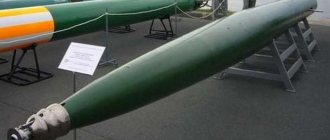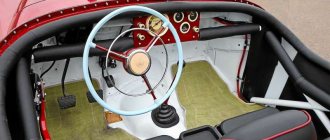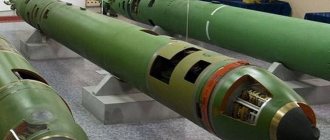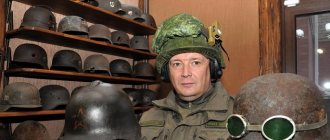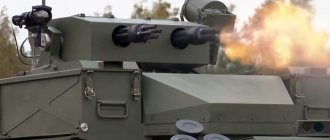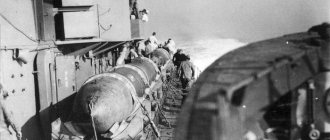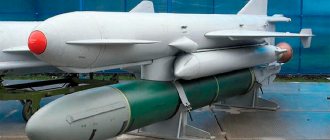History of the creation of the torpedo
In a general sense, by torpedo we mean a metal cigar-shaped or barrel-shaped military projectile that moves independently. The projectile received this name in honor of the electric stingray about two hundred years ago. The naval torpedo occupies a special place. It was the first to be invented and the first to be used in the military industry.
In a general sense, a torpedo is a streamlined barrel-shaped body, inside of which there is an engine, a nuclear or non-nuclear warhead and fuel. The tail and propellers are installed outside the hull. And the command to the torpedo is given through the control device.
The need for such weapons arose after the creation of submarines. At this time, towed or pole mines were used, which did not carry the required combat potential in a submarine. Therefore, the inventors were faced with the question of creating a combat projectile, smoothly flowing around water, capable of moving independently in the aquatic environment, and which would be able to sink enemy submarines and surface vessels.
Torpedoes and Mines
Varieties
Torpedo - self-propelled sea mine
sea mine
"Zircon" and "Skif" - bottom weapons of the Russian Navy
Multiple launch rocket system on a ship
Images
Torpedo squallOrigin of the term
In Russian, like other European languages, the word “torpedo” is borrowed from English (English torpedo) [].
There is no consensus regarding the first use of this term in English. Some authoritative sources claim that the first recording of this term dates back to 1776 and it was introduced into circulation by David Bushnell, inventor of one of the first prototype submarines, the Turtle. According to another, more widespread version, the primacy of the use of this word in English belongs to Robert Fulton and dates back to the beginning of the 19th century (no later than 1810)
In both cases, the term “torpedo” did not designate a self-propelled cigar-shaped projectile, but an egg- or barrel-shaped underwater contact mine, which had little in common with the Whitehead and Aleksandrovsky torpedoes.
Originally in English, the word “torpedo” refers to electric stingrays, and has existed since the 16th century and was borrowed from the Latin language (lat. torpedo), which in turn originally meant “numbness,” “rigidity,” “immobility.” The term is associated with the effect of the “strike” of an electric ramp.
When did the first torpedoes appear?
The torpedo, or as it was called at that time - a self-propelled sea mine, was invented by two scientists at once, located in different parts of the world, who had nothing to do with each other. This happened almost at the same time.
In 1865, Russian scientist I.F. Aleksandrovsky, proposed his own model of a self-propelled mine. But it became possible to implement this model only in 1874.
In 1868, Whitehead presented to the world his scheme for building a torpedo. In the same year, Austria-Hungary acquired a patent for the use of this scheme and became the first country to possess this military equipment.
In 1873, Whitehead offered to purchase the scheme to the Russian fleet. After testing the Alexandrovsky torpedo in 1874, it was decided to purchase Whitehead’s combat shells, because the modernized development of our compatriot was significantly inferior in technical and combat characteristics. Such a torpedo significantly increased its ability to sail strictly in one direction, without changing course, thanks to the pendulums, and the speed of the torpedo almost doubled.
Thus, Russia became only the sixth owner of the torpedo, after Great Britain, France, Germany and Italy. Whitehead put forward only one restriction for the purchase of a torpedo - to keep the projectile construction scheme secret from states that did not want to buy it.
Already in 1877, Whitehead torpedoes were used in combat for the first time.
Combat use
The first state to use the new weapon in action was Russia. Torpedoes were used during the Russo-Turkish War of 1877-78 and were launched from boats. The second major war using torpedoes was the Russo-Japanese War of 1905.
During the First World War, weapons were used by all belligerents not only in the seas and oceans, but also on river communications. Germany's extensive use of submarines led to heavy losses in the Entente and Allied merchant fleets. During the Second World War, improved versions of weapons began to be used, equipped with electric motors and improved guidance and maneuvering systems.
Torpedo tube design
As the name suggests, a torpedo tube is a mechanism designed for firing torpedoes, as well as for transporting and storing them while traveling. This mechanism has the shape of a tube identical to the size and caliber of the torpedo itself. There are two shooting methods: pneumatic (using compressed air) and hydropneumatic (using water that is displaced by compressed air from a designated reservoir). Installed on a submarine, the torpedo tube is a fixed system, while on surface ships, the device can be rotated.
The operating principle of a pneumatic torpedo apparatus is as follows: when receiving the “start” command, the first drive opens the cover of the apparatus, and the second drive opens the valve of the compressed air tank. The compressed air pushes the torpedo forward, and at the same time a microswitch is activated, which turns on the motor of the torpedo itself.
For a pneumatic torpedo tube, scientists have created a mechanism that can disguise the location of a torpedo shot under water - a bubble-free mechanism. The principle of its operation was as follows: during the shot, when the torpedo had passed two-thirds of its path through the torpedo tube and acquired the required speed, a valve opened through which compressed air went into the strong hull of the submarine, and instead of air, due to the difference between the internal and external pressure, the apparatus was filled with water until the pressure balanced. Thus, there was practically no air left in the chamber, and the shot went unnoticed.
The need for a hydropneumatic torpedo tube arose when submarines began to dive to depths of more than 60 meters. The shot required a large amount of compressed air, and it was too heavy at such a depth. In a hydropneumatic apparatus, the shot is fired by a water pump, the impulse from which pushes the torpedo.
See also[edit | edit code]
- Torpedo attack
- Rocket torpedo
- A sea mine (the original definition of a torpedo was a “self-propelled mine”) a towed mine - the first weapon of the first mine boats (a sea mine towed into an attack using a cable)
- pole mine - a mine attached to a pole in front of a mine boat and exploding when it hits an obstacle
- throwing mine
aircraft:
- Torpedo bomber
- Kettering aerial torpedo
ships:
- Submarine
- torpedo boat
- Destroyer
- Destroyer
other:
- Torpedo Data Computer is one of the earliest analog computers, used on American submarines of World War II to calculate the course of a torpedo.
- Bangalore torpedo
Types of torpedoes
- Depending on the type of engine: compressed air, steam-gas, powder, electric, jet;
- Depending on the guidance ability: unguided, upright; capable of maneuvering along a given course, homing passive and active, remote-controlled.
- Depending on the purpose: anti-ship, universal, anti-submarine.
One torpedo includes one point from each unit. For example, the first torpedoes were an unguided anti-ship warhead with a compressed air engine. Let's consider several torpedoes from different countries, different times, with different mechanisms of action.
In the early 90s, the Russian fleet acquired the first boat capable of moving underwater - the Dolphin. The torpedo tube installed on this submarine was the simplest - pneumatic. Those. the type of engine, in this case, was compressed air, and the torpedo itself, in terms of guidance ability, was uncontrollable. The caliber of torpedoes on this boat in 1907 varied from 360 mm to 450 mm, with a length of 5.2 m and a weight of 641 kg.
In 1935-1936, Russian scientists developed a torpedo tube with a powder engine. Such torpedo tubes were installed on type 7 destroyers and light cruisers of the Svetlana type. The warheads of such a device were 533 caliber, weighing 11.6 kg, and the weight of the powder charge was 900 g.
In 1940, after a decade of hard work, an experimental device with an electric motor was created - ET-80 or “Product 115”. A torpedo fired from such a device reached a speed of up to 29 knots, with a range of up to 4 km. Among other things, this type of engine was much quieter than its predecessors. But after several incidents involving battery explosions, the crew used this type of engine without much desire and was not in demand.
Supercavitation torpedo
In 1977, a project with a jet engine was presented - the VA 111 Shkval supercavitation torpedo. The torpedo was intended to destroy both submarines and surface vessels. The designer of the Shkval rocket, under whose leadership the project was developed and implemented, is rightfully considered G.V. Logvinovich. This torpedo missile developed simply amazing speed, even for the present time, and inside it, for the first time, a nuclear warhead with a power of 150 kt was installed.
Shkval torpedo device
Technical characteristics of the VA 111 “Shkval” torpedo:
- Caliber 533.4 mm;
- The length of the torpedo is 8.2 meters;
- The projectile speed reaches 340 km/h (190 knots);
- Torpedo weight – 2700 kg;
- Range up to 10 km.
- The Shkval missile-torpedo also had a number of disadvantages: it generated very strong noise and vibration, which negatively affected its ability to camouflage; its travel depth was only 30 m, so the torpedo in the water left a clear trail behind itself and was easy to detect , and it was impossible to install a homing mechanism on the torpedo head itself.
For almost 30 years, there was no torpedo capable of withstanding the combined characteristics of the Shkval. But in 2005, Germany proposed its development - a supercavitation torpedo called “Barracuda”.
The principle of its operation was the same as that of the Soviet “Shkval”. Namely: a cavitation bubble and movement in it. The Barracuda can reach speeds of up to 400 km/h and, according to German sources, the torpedo is capable of homing. Disadvantages also include strong noise and small maximum depth.
Principle of operation
On torpedoes of the 53-39 type, before use, you must manually set the parameters for the depth of movement, course and approximate distance to the target. After this, it is necessary to open the safety valve installed on the compressed air supply line to the combustion chamber.
When the torpedo passes the launch tube, the main valve automatically opens and air begins to flow directly into the chamber.
At the same time, kerosene begins to be sprayed through the nozzle and the resulting mixture is ignited using an electrical device. An additional nozzle installed in the chamber supplies fresh water from the on-board tank. The mixture is fed into a piston engine, which begins to spin the coaxial propellers.
For example, the German G7a steam-gas torpedoes use a 4-cylinder engine equipped with a gearbox to drive coaxial propellers rotating in the opposite direction. The shafts are hollow, installed one inside the other. The use of coaxial screws allows the deflecting moments to be balanced and the specified course of movement is maintained.
During startup, part of the air is supplied to the gyroscope spin-up mechanism.
After the head part begins to come into contact with the water flow, the rotation of the fighting compartment fuse impeller begins. The fuse is equipped with a delay device, which ensures that the striker is cocked into firing position after a few seconds, during which the torpedo will move 30-200 m from the launch site.
The deviation of the torpedo from the given course is corrected by the gyroscope rotor, which acts on the rod system connected to the rudders actuating machine. Electric drives can be used instead of rods. The error in stroke depth is determined by a mechanism that balances the spring force with the pressure of the liquid column (hydrostat). The mechanism is connected to the depth steering actuator.
When the warhead hits the ship's hull, the firing pins destroy the primers, which cause detonation of the warhead. German G7a torpedoes of later series were equipped with an additional magnetic detonator, which was triggered when a certain field strength was reached. A similar fuze has been used since 1942 on Soviet 53-38U torpedoes.
Comparative characteristics of some submarine torpedoes of the Second World War are given below.
| Parameter | G7a | 53-39 | Mk.15mod 0 | Type 93 |
| Manufacturer | Germany | USSR | USA | Japan |
| Case diameter, mm | 533 | 533 | 533 | 610 |
| Charge weight, kg | 280 | 317 | 224 | 610 |
| Explosive type | TNT | TGA | TNT | – |
| Maximum range, m | up to 12500 | up to 10000 | up to 13700 | up to 40000 |
| Working depth, m | up to 15 | up to 14 | – | – |
| Travel speed, knots | up to 44 | up to 51 | up to 45 | up to 50 |
Targeting
The simplest guidance technique is to program the course of movement. The course takes into account the theoretical linear displacement of the target during the time required to cover the distance between the attacking and attacked ship.
A noticeable change in the speed or course of the attacked ship leads to the torpedo passing by. The situation is partly saved by launching several torpedoes in a “fan” pattern, which makes it possible to cover a larger range. But such a technique does not guarantee hitting the target and leads to excessive consumption of ammunition.
Before the First World War, attempts were made to create torpedoes with course correction via a radio channel, wires or other methods, but it did not reach mass production. An example is John Hammond the Younger's torpedo, which used the light of an enemy ship's searchlight for homing.
To provide guidance, automatic systems began to be developed in the 1930s.
The first were guidance systems based on the acoustic noise emitted by the propellers of the attacked ship. The problem is low-noise targets, the acoustic background from which may be lower than the noise of the propellers of the torpedo itself.
To eliminate this problem, a guidance system was created based on reflected signals from the ship’s hull or the wake jet created by it. To adjust the movement of a torpedo, wire-based telecontrol techniques can be used.
Carriers of torpedo weapons
As mentioned above, the first carrier of torpedo weapons is a submarine, but besides it, of course, torpedo tubes are also installed on other equipment, such as airplanes, helicopters and boats.
Torpedo boats are light, lightweight boats equipped with torpedo launchers. They were first used in military affairs in 1878-1905. They had a displacement of about 50 tons, and were armed with 1-2 torpedoes of 180 mm caliber. After this, development went in two directions - increasing displacement and the ability to carry more installations on board, and increasing the maneuverability and speed of a small vessel with additional ammunition in the form of automatic weapons up to 40 mm caliber.
Light torpedo boats from World War II had almost identical characteristics. Let's take the Soviet G-5 project boat as an example. This is a small fast boat weighing no more than 17 tons, had on board two 533 mm caliber torpedoes and two 7.62 and 12.7 mm caliber machine guns. Its length was 20 meters, and its speed reached 50 knots.
Heavy torpedo boats were large warships with a displacement of up to 200 tons, which we used to call destroyers or mine cruisers.
In 1940, the first prototype of a torpedo missile was presented. The homing missile launcher had a 21 mm caliber and was dropped from anti-submarine aircraft by parachute. This missile hit only surface targets and therefore remained in service only until 1956.
In 1953, the Russian fleet adopted the RAT-52 torpedo missile. Its creator and designer is considered to be G.Ya. Dilon. This missile was carried on board aircraft such as Il-28T and Tu-14T.
The missile did not have a homing mechanism, but the speed of hitting the target was quite high - 160-180 m/s. Its speed reached 65 knots, with a range of 520 meters. The Russian Navy used this installation for 30 years.
Soon after the creation of the first aircraft carrier, scientists began to develop a model of a helicopter capable of arming itself and attacking with torpedoes. And in 1970, the Ka-25PLS helicopter was adopted by the USSR. This helicopter was equipped with a device capable of releasing a torpedo without a parachute at an angle of 55-65 degrees. The helicopter was armed with an AT-1 aircraft torpedo. The torpedo was 450 mm caliber, with a control range of up to 5 km and a depth of entry into the water of up to 200 meters. The motor type was an electric disposable mechanism. During the shot, electrolyte was poured into all batteries from one container at once. The shelf life of such a torpedo was no more than 8 years.
Torpedoes of the Russian fleet of the early twentieth century and the First World War
In 1871, Russia achieved the lifting of the ban on keeping the navy in the Black Sea. The inevitability of war with Turkey forced the Naval Ministry to speed up the rearmament of the Russian fleet, so Robert Whitehead’s offer to purchase a license for the production of torpedoes of his design came in handy. In November 1875, a contract was prepared for the purchase of 100 Whitehead torpedoes designed specifically for the Russian Navy, as well as the exclusive right to use their designs. Special workshops for the production of torpedoes were created in Nikolaev and Kronstadt under Whitehead’s license. The first domestic torpedoes began to be produced in the fall of 1878, after the start of the Russian-Turkish War.
Mine boat Chesma
Despite the repeated order of torpedoes in Fiume, the Naval Ministry organized the production of torpedoes at the Lessner boiler plant, the Obukhov plant and in already existing workshops in Nikolaev and Kronstadt. By the end of the 19th century, up to 200 torpedoes were produced in Russia per year. Moreover, each batch of manufactured torpedoes underwent sighting tests without fail, and only then entered service. In total, until 1917, the Russian fleet had 31 modifications of torpedoes. Most of the torpedo models were modifications of Whitehead torpedoes, a small part of the torpedoes were supplied by the Schwarzkopf factories, and in Russia the torpedo designs were further developed. Inventor A.I. Shpakovsky, who collaborated with Aleksandrovsky, in 1878 proposed using a gyroscope to stabilize the course of a torpedo, not yet knowing that Whitehead torpedoes were equipped with a similar “secret” device. In 1899, Lieutenant of the Russian Navy I. I. Nazarov proposed his own design of an alcohol heater. Lieutenant Danilchenko developed a project for a powder turbine for installation on torpedoes, and mechanics Khudzynsky and Orlovsky subsequently improved its design, but the turbine was not accepted for mass production due to the low technological level of production.
Whitehead torpedo
DestroyersBaltic FleetFirst World War
In 1912, a unified designation began to be used to designate torpedoes, consisting of two groups of numbers: the first group is the rounded caliber of the torpedo in centimeters, the second group is the last two digits of the year of development. For example, type 45-12 stood for a 450 mm torpedo developed in 1912. The first completely Russian torpedo of the 1917 model, type 53-17, did not have time to go into mass production and served as the basis for the development of the Soviet torpedo 53-27.
Main technical characteristics of torpedoes of the Russian fleet before 1917
| Comparative table of torpedoes of the Russian fleet until 1917 | |||||||||
| Type | Year of development | Caliber, mm | Length, m | Total weight, kg | Explosive mass, kg | Travel range, m | Travel speed, knots | engine's type | Applicability |
| Alexandrovsky24-inch | 1868 | 610 | 5,82 | 1000 | 762 | 6-8 | 1-cylinderair | did not enter service | |
| Alexandrovsky22-inch | 1868 | 560 | 7,34 | 1000 | 10-12 | 1-cylinderair | did not enter service | ||
| Alexandrovsky24-inch mod. | 1875 | 610 | 6,1 | 18 | 2-cylinder air | did not enter service | |||
| Whitehead arr. 1876 | 1876 | 381 | 5,73 | 350 | 26 | 400 | 20 | 2-cylinder air | |
| Whitehead arr. 1880 | 1880 | 381 | 4,56 | 324 | 33 | 400 | 20 | 2-cylinder air | mine boats |
| Whitehead arr. 1882 | 1882 | 355 | 3,35 | 197 | 40 | 550 | 21 | 2-cylinder air | |
| Whitehead arr. 1886 | 1886 | 381 | 5,52 | 391 | 40 | 600 | 24 | 2-cylinder air | armadillos |
| Whitehead arr. 1889 type "B" | 1889 | 381 | 5,52 | 395 | 80 | 600 | 22 | 2-cylinder air | |
| Whitehead arr. 1889 type "O" | 1889 | 381 | 5,52 | 420 | 80 | 600 | 25 | 2-cylinder air | |
| Whitehead arr. 1894 type "C" | 1894 | 381 | 5,52 | 455 | 80 | 600 | 27 | 3-cylinder air | |
| Whitehead arr. 1897 type "C" | 1894 | 381 | 5,2 | 426 | 64 | 400900 | 3025 | 3-cylinder air | |
| Whitehead arr. 1898 type "L" | 1894 | 381 | 5,18 | 430 | 64 | 400900 | 3025 | 3-cylinder air | cruisers, destroyers |
| Whitehead arr. 1904 | 1904 | 450 | 5,13 | 648 | 70 | 8002000 | 3325 | 3-cylinder air | cruisers, destroyers |
| Schwartzkopff B/50 | 1904 | 450 | 3,55 | 390 | 50 | 800 | 24 | 3-cylinder air | submarines, cruisers, destroyers |
| Whitehead arr. 1907 | 1907 | 450 | 5,2 | 641 | 90 | 60010002000 | 403427 | 3-cylinder air | submarines |
| Whitehead arr. 1908 | 1908 | 450 | 5,2 | 650 | 95 | 100020003000 | 383428 | 4-cylinderair | |
| Whitehead arr. 1910 type "L" | 1910 | 450 | 5,2 | 665 | 100 | 1000200030004000 | 38342925 | 4-cylinderair | |
| 45-12 | 1912 | 450 | 5,58 | 810 | 100 | 200050006000 | 433028 | 2-cylinder air | surface ships |
| 45-15 | 1915 | 450 | 5,2 | 665 | 100 | 200050006000 | 433028 | 4-cylinderair | submarines |
| 53-17 | 1917 | 533 | 7,0 | 1700 | 265 | 3000 | 32 | 3-cylinder air | did not enter service |
From prosperity to survival
At first, Dagdizel produced steam-gas torpedoes, and since the 60s of the 20th century, the production of electric torpedoes became the main direction of the plant’s work. Subsequently, broadband mine systems and thermal torpedoes using unitary fuel were manufactured here, and Dagdizel was the only USSR enterprise that carried out their large-scale production.
In the post-war period, the main manufacturers of torpedoes for the USSR Navy were the plant named after. Kirov (Almaty, Kazakhstan), (Leningrad), plant named after. 50th anniversary of the Kyrgyz SSR (now Dastan Corporation, Kyrgyzstan).
The development of torpedoes was carried out by NII-400 (the future Central Research Institute Gidropribor), the design bureau of the plant named after. Kirov (torpedo 53-65K of 1970 and works of the 80s on the “Magot” theme), branch of NII-400 in Lomonosov (future Morteplotekhnika OJSC).
Collage by Andrey Sedykh
In 1973, torpedo developers and manufacturers were united into the specialized NPO Uran. From the standpoint of today, this was a very controversial decision. If in the 50-60s our torpedoes looked very decent in comparison with foreign analogues (a number of models developed at that time are still in service and in demand for export), then the results of the work of NPO Uran are 70-80- x are depressing. At the time of the collapse of the USSR, in no other types and types of weapons and military equipment did the Soviet Union lag behind its potential enemy as significantly as in the field of naval underwater weapons.
After December 1991, NPO Uran ceased to exist. “Dagdizel”, “Dvigatel”, “Gidropribor” and “Morteplotekhnika” remained on the territory of the Russian Federation. During that difficult period, each enterprise “floated” independently.
The 90s were extremely difficult for Dagdizel. The issue of deploying its own R&D became acute for the plant - as a condition for the survival and development of the enterprise.
